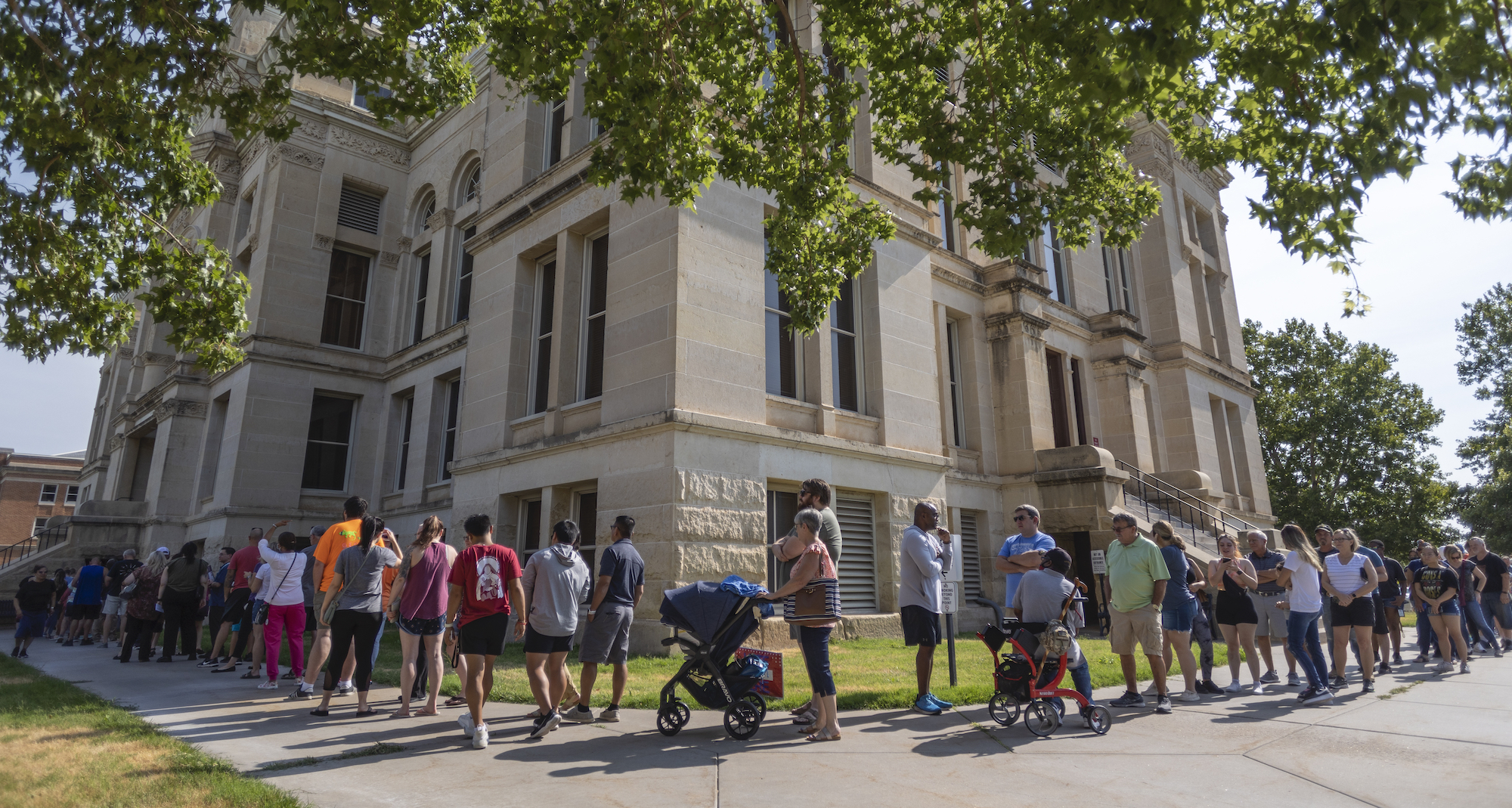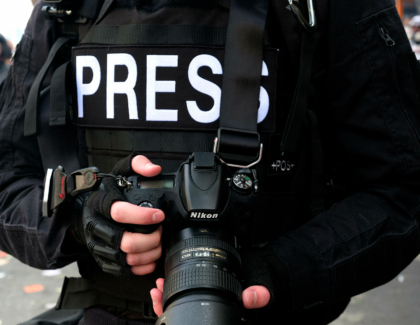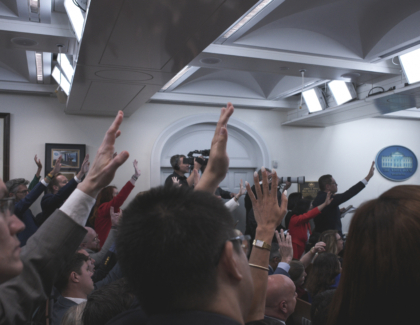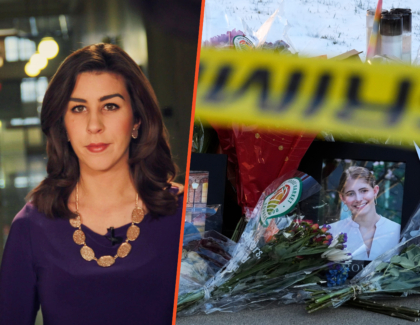Sign up for the daily CJR newsletter.
In the weeks leading up to Missouri’s Republican US Senate primary in early August, a closely watched question hung over media coverage of the race: Who would Donald Trump endorse? Axios called it one of several “big tests” for “Trump’s influence in the party”; CNN listed it as one of three questions that would shape whether Missouri would be in play come fall; a local TV station referred to it as “the needed edge to pull off a win in this primary,” according to “many.” In early July, Trump made it known that he would not be backing Vicky Hartzler in the race (a blow to her candidacy, various outlets reported, even if she would “press on” through the resultant “headwinds”), narrowing media endorsement chatter to two candidates: Eric Schmitt, Missouri’s attorney general, and Eric Greitens, the state’s disgraced former governor. Domestic-abuse allegations against Greitens—and his “declining poll numbers”—put Schmitt in an “enviable position” for the endorsement, Politico reported, but Kimberly Guilfoyle, the former Fox host turned Greitens staffer (and partner of Don Jr.), was still lobbying Trump to pick her guy. Trump himself seemed to revel in the attention, telling the far-right One America News Network, “They say whoever I endorse in Missouri is going to win.”
Late on the day before the primary, Trump put an end to the suspense by endorsing “ERIC.” A last name was not forthcoming, leading confused media outlets to note that there were two Erics in the race and that Trump’s endorsement could refer to either one. (Actually, this was fake news: there were three Erics in the race.) Apparently, the confusion was intentional, with Trump opting against making a firm decision after weighing polling in the race and hearing contrasting entreaties from different people in his orbit. Politico reported that, in the hours leading up to his “ERIC” announcement, Trump “went in on the details, asking if the two candidates’ first names were spelled identically—noting that it wouldn’t work if they weren’t.”
ICYMI: The threats facing student journalism
The furor over Trump’s Missouri pick was the farcical nadir of a much longer-running media fixation that shaped coverage of primary season: the idea that Trump’s endorsements were the factor to watch in Republican races, and that his batting average would speak authoritatively to his present political strength. I wrote, after this narrative first emerged, that treating the success or failure of individual Trump-endorsed candidates as a neat proxy for his broader standing was a bad idea for several reasons, including the facts that disparate local races are hard to cleanly lump together and that Trump could simply game the media’s endorsement framing by strategically backing front-runners, then basking in whatever glory they reflected back onto him. Ultimately, the endorsement obsession seemed likely to induce confusing narrative whiplash, and so it proved. The result of the Senate primary in Ohio in May was “A Trump Win.” The results of primaries in Georgia in June were “a string of embarrassing rebukes.” The results of primaries in Wyoming and Alaska in August “demonstrated the enduring strength of Trump.” And so on.
As the primary calendar drew to a close—it ended yesterday, unless you’re a pedant or from Louisiana—coverage of Trump’s endorsements persisted; in recent days, major outlets have tallied his overall success rate, and there was some media anticipation as to whether Trump would make a last-minute intervention in what was billed as the final big race of the cycle, the Republican US Senate primary in New Hampshire. The latter, though, sometimes seemed to lack energy. The New York Times assessed, for example, that while a Trump endorsement “might still influence the race,” its “impact has diminished with each passing day,” before wearily noting Trump’s cycle-long strategy of “waiting for a front-runner to emerge, letting him run up his win-loss record and boast of his political influence.” (In the end, Trump didn’t endorse, obviously because the leading candidates had different first names.)
At least as I’ve observed things, this mirrors a broader waning of media interest in the Trump-endorsement story line, at least compared with its earlier saturation point. That might reflect that it ultimately offered the press no single, simple narrative to take away (I did try to warn you), but it also likely reflects the emergence of much bigger Trump stories in the meantime, not least the January 6 hearings over the summer and the subsequent FBI search of Mar-a-Lago. These stories are legitimately much more important than the endorsement one. They’ve also provided political reporters with the opportunity to pivot to fresher—yet still hugely oversimplified—proxies for Trump’s political strength. (Down, we were told, after the damaging January 6 revelations; up, we were told, as Republicans rallied around him in outrage after the Mar-a-Lago search.)
As the primary calendar advanced, these seismic stories fed into broader narratives around the midterms, while different, narrower midterm narratives took hold, too, with varying degrees of usefulness for the civic conversation. One prominent example has been the story of the Democratic Party meddling to boost extreme anti-democracy candidates in tight Republican primaries—the idea being that they’d be easier to beat in the fall, and the form, often, being ad campaigns that criticized the given candidates but in language (“too conservative”) likely to appeal to Republican primary voters. The trend prompted a great deal of coverage as well as chatter on cable news, often coming up in anchors’ interviews with senior Democratic politicians. In many ways, this was fair—big money in politics always merits scrutiny, and it’s totally legitimate to interrogate the risks of such a strategy. Still, the story seemed to me, at least sometimes, to cross the line into overblown territory, recurring as an easy “both sides” cudgel that reporters and pundits could use to beat Democrats for hypocrisy. Ultimately, Democrats weren’t the ones holding or voting for the extreme anti-democracy positions, which always mattered most here. And the implied dichotomy in some of this coverage—between anti-democratic extremists and a rump of pro-democracy GOP moderates—always demanded interrogation, too.
The intersection of the midterms and a much bigger story, abortion, has also been interesting to behold: the latter exploded into the news cycle in early May, when Politico published the draft Supreme Court opinion overturning Roe v. Wade, then again in late June, when the decision was confirmed, with no little of the voluminous coverage assessing how the ruling might alter the midterm landscape. At least to my mind, though, the latter genre of coverage often seemed to downplay just how restructuring a development the overturning of Roe was likely to be in American politics—at least until early August, when, on the same day the Erics fought it out in Missouri, voters in Kansas overwhelmingly opted to protect abortion access in a ballot initiative that only really blew up as a major national story after the result came in. (Politico: “Roe jolts the midterms”; The New Republic: “Kansas Voters Just Rewrote the Script for the Midterm Elections.”) The Kansas result drove the greatest spike in discussions about abortion on cable news since Roe was overturned; those have since ticked down again, but Kansas, to my mind, wired abortion into the midterms news cycle more durably than it was before.
Of course, the electoral horse race is not the most important prism when it comes to covering reproductive rights. Ever since the leaked Roe opinion, there’s been some great coverage of its immediate consequences across the country. We’ve also seen some good coverage of other policy areas that feed into the midterms story. Still, as November has neared, a horserace framing has persisted and intensified across swaths of major media. The midterms, of course, are elections, and elections set policy, so it’s not inappropriate to cover who looks likely to win them, especially when they get close. Rather, when media watchers (myself included) criticize horserace journalism, it’s a criticism of proportion (the fact that such coverage can drown out everything else, including scrutiny of candidates’ policy stances) and framing (the boiling down of weighty matters, like the Mar-a-Lago search, to shallow questions of political advantage and strength).
As I wrote at the time, Biden’s recent speech warning of extreme Republican threats to the future of American democracy was another recent example of a story that got distorted by a widespread media focus on horserace optics. That was particularly concerning because the state of democracy always should have been the overarching story line of this midterm cycle: after all, it underpins the basic fairness of the horserace, as well as the contours of every aspect of public policy. When Molly Jong-Fast, of The Atlantic, asked media-watchers (myself included) to offer midterm tips to the political press back in March, all of her interlocutors advised focusing first on anti-democratic threats; the academic Jay Rosen argued that the media should “redraw the baseline for election-year conflict,” moving past “Democrats vs. Republicans in a familiar battle for control of government” to “a more urgent contest: those from both parties who still abide by the norms of American democracy vs. those who have demonstrated they do not.” A full primary calendar later, it’s hard to conclude that this happened in a consistent way. We’ve seen some very good coverage of election deniers maneuvering themselves closer to positions of immense political power. We’ve also seen reams of coverage that has treated 2022 as a normal election year, including by framing election denialism through a prism of savvy politics, rather than clear threat.
The media obsession over Trump’s endorsements was a prime example of coverage that put horserace considerations ahead of deeper questions about candidates’ actual stances. When I wrote about it earlier in the cycle, I noted another reason that endorsements were a limiting prism: their failure to account for the success of candidates who didn’t win Trump’s explicit backing, but nonetheless won on a Trumpian platform, not least around election denialism. In the run-up to the “ERICS” endorsement, both Greitens and Schmitt sought to cast themselves as reliably pro-Trump, including in their support for the former president’s lies about the 2020 election.
In the end, Schmitt won in Missouri. By FiveThirtyEight’s recent count, he is now one of 199 “full” election deniers running in a major race this fall; in all, 60 percent of Americans will have an election denier on the ballot when they go to vote. Now that the primaries are over, it’s not too late to pivot wholeheartedly to center the threat this poses. But it’s getting that way.
Below, more on the midterms:
- Cover climate now: The editors of Covering Climate Now, a climate-reporting initiative founded by CJR and The Nation, wrote last week that the midterms are a climate story, too, and that the press should remember that in its coverage. “It is not unprofessional editorializing for news coverage to make clear the implications these elections hold for civilization’s future—it is factually accurate,” the editors wrote. “Nor is it partisan to make clear that one of the US’s two main political parties has for decades refused to acknowledge the climate crisis, much less offer credible proposals for combating it. That, too, is simply factually accurate.” Ultimately, “voters deserve to know where candidates stand on this life-and-death issue, and they need journalists’ help to do it.”
- Threats to democracy: Aliyya Swaby and Annie Waldman, of ProPublica, took a deep dive into a very old effort to stop certain Americans from voting: restrictions that affect those who struggle to read. “For all of the recent uproar over voting rights, little attention has been paid to one of the most sustained and brazen suppression campaigns in America,” Swaby and Waldman write, noting that more than a fifth of the adult US population struggles to read. “Some states have required voters who needed help to sign an affidavit explaining why they need assistance; some have prevented voters who couldn’t read from bringing sample ballots to the polls and limited the number of voters that a volunteer could help read a ballot. Time and again, federal courts have struck down such restrictions as illegal and unconstitutional. Inevitably, states just create more.”
- Poll position: Nate Cohn, the elections-data maven at the Times, issued a warning this week around horserace polling that seems to show Democrats in a strong position in certain midterm Senate races compared with others, noting that Democratic candidates are “outrunning expectations” in places, like Wisconsin, where polls also overestimated support for Hillary Clinton in 2016 and Joe Biden in 2020. Nothing, obviously, is set in stone yet, but “if the polls are wrong yet again, it will not be hard to explain,” Cohn wrote. “Most pollsters haven’t made significant methodological changes since the last election. The major polling community post-mortem declared that it was ‘impossible’ to definitively ascertain what went wrong in the 2020 election.”
Other notable stories:
- Yesterday, Peiter Zatko, the Twitter security chief turned whistleblower, testified before the Senate Judiciary Committee, blasting his former employer’s data-security practices and making a “convincing case,” Vox concluded, that “Twitter is a mess.” Meanwhile, The New Yorker’s Ronan Farrow reported that finance-world research firms have been offering cash to people with whom Zatko has worked, with the apparent intention of digging up “dirt” about him, one source told Farrow. Investors want to know more about Zatko’s credibility in the context of Twitter’s legal battle with Elon Musk, who is trying to wriggle out of his deal to buy the company. Yesterday, shareholders voted to approve Musk’s bid, allowing Twitter to proceed with its legal case that Musk must follow through.
- Also yesterday, Gavin Newsom, California’s governor, signed off on a new law that will force major social media platforms to disclose their content-moderation policies to the state’s attorney general, including details on how they handle hate speech, extremism, and disinformation. The state lawmaker who wrote the bill claims that it constitutes the most stringent set of transparency requirements around this sort of content anywhere in the world, but tech companies and their advocates could yet challenge the law in court, with at least one legal expert describing it as “censorial” and thus “unconstitutional.”
- The Verge, a tech-news outlet, unveiled a redesign driven by the conviction that its site should not merely project a consistent identity for its content across other platforms, but that its “own platform should be an antidote to algorithmic news feeds.” The Verge’s homepage now features a curated feed with “the best of tech and science news from around the entire internet,” after editors concluded, “well shit, we just need to blog more.”
- Yesterday, a damages trial got underway in Connecticut to determine how much the conspiracy theorist Alex Jones must pay people he defamed following the 2012 Sandy Hook shooting—the second of three such trials Jones must face. The jury in the first trial, in Texas, ordered a huge payout, though state law capped it. If the Connecticut verdict is similar, Jones is likelier to have to pay up. (I wrote about Jones following the Texas trial.)
- Alex Burns, formerly a politics reporter at the Times, is rejoining Politico as a columnist and associate editor for global politics, as the site seeks to become “a more truly global newsroom.” In other media-jobs news, NPR named Brittany Luse as the new host of its culture show It’s Been a Minute, succeeding Sam Sanders. And Wesley Lowery is joining the City University of New York’s journalism school as a journalist in residence.
- Tayson Latigue and Frantzsen Charles, two journalists in Haiti, were killed in an area controlled by gangs, the AP reports. Their bodies were set on fire; five other journalists were attacked but managed to escape. The gang-related double killing was the second of its kind this year, following that of John Wesley Amady and Wilguens Louis-Saint in January. CJR’s Feven Merid wrote about their cases and others back in May.
- The Committee to Protect Journalists called on intelligence services in the Netherlands to investigate after Stella Braam, an investigative reporter, discovered that an agency surveilled her between 1986 and 2017 (and probably since then) due to her contacts with sources linked to the Dutch activities of Turkish nationalist groups. After learning of the surveillance, Braam quit her job out of concern for the confidentiality of her sources.
- And The Cut’s Danya Issawi spoke with Martha Stewart about her recent focus on “projects that cater to the youths” and her use of social media, including the art of the Instagram thirst trap. “That first thirst trap, I didn’t even know what a thirst trap was when I took that picture,” Stewart said. “I had no idea, and I just thought, You look really hot, Martha. This is great, post it. So I posted it, and that’s when it became a thirst trap.”
ICYMI: The killing of Jeff German
Has America ever needed a media defender more than now? Help us by joining CJR today.







